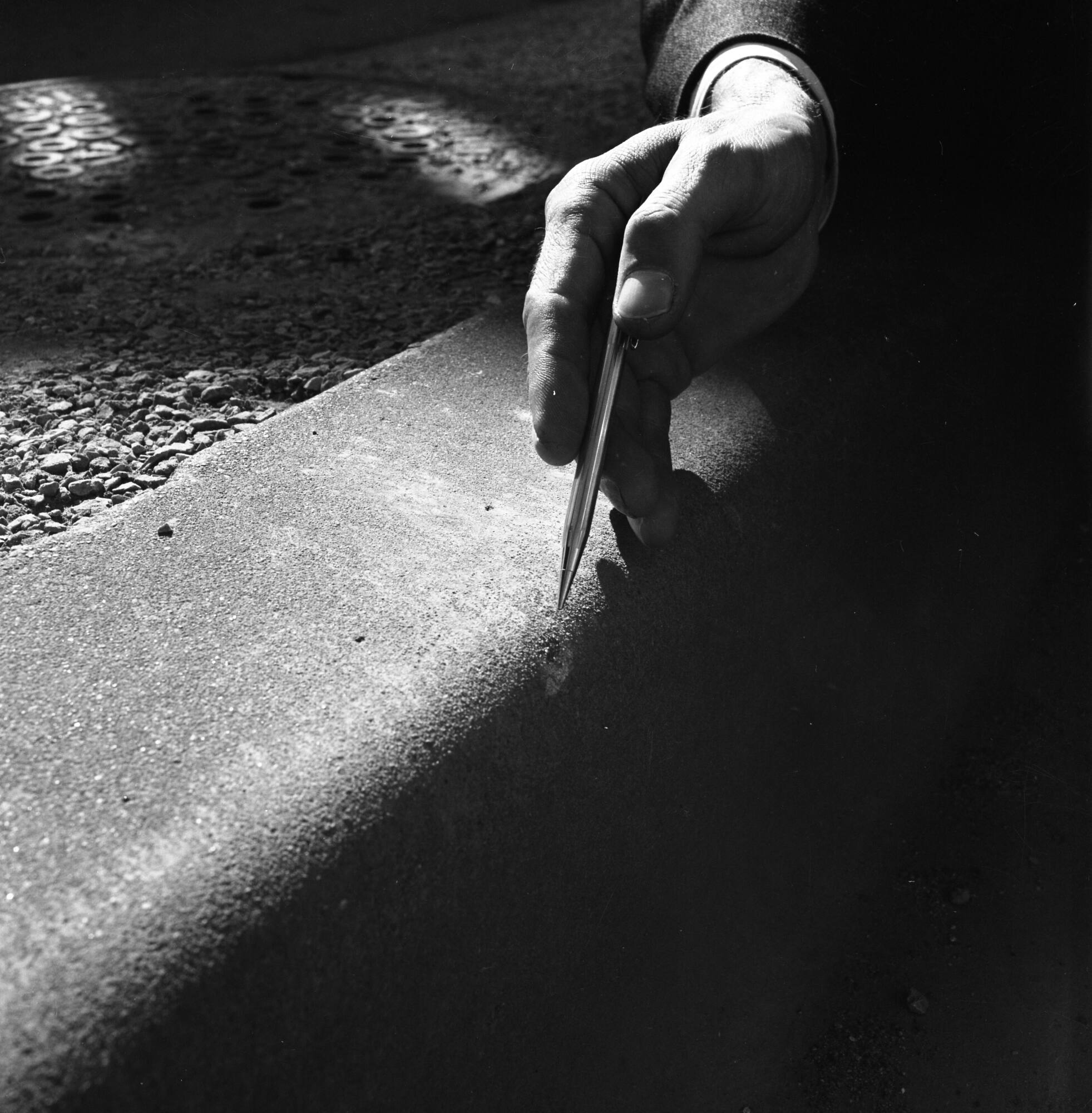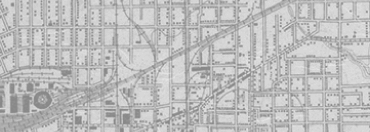


Back
Image of a bullet mark on a curb in Dealey Plaza
Original black and white negative by Dallas Morning News photographer Tom C. Dillard. This image shows the right hand of KRLD-TV reporter Jim Underwood using Dillard's ballpoint pen to indicate a mark on the south curb of Main Street near the triple underpass in Dealey Plaza that was likely caused by a bullet. This photo was taken after 1:31 p.m. on Saturday, November 23, 1963, the day after the assassination.
Image of a bullet mark on a curb in Dealey Plaza
11/23/1963
Film
2 3/16 × 2 3/16 in. (5.6 × 5.6 cm)
Tom C. Dillard Collection, The Dallas Morning News/The Sixth Floor Museum at Dealey Plaza
1994.003.0045.0002
Although James Tague had no intention of seeing the Kennedy motorcade on November 22, 1963, he ended up becoming one of the most significant eyewitnesses in Dealey Plaza. Driving east on Commerce Street prior to the parade, Tague was stopped by traffic halfway underneath the Triple Underpass. He got out of his car, initially thinking the delay might be due to an automobile accident. In his Museum oral history, Tague explained, "There's about [two feet] between Commerce and Main at that point, and I was standing on the concrete between the two." From that vantage, Tague saw the Kennedy motorcade and felt a sting on his face during the shooting. He recalled, "It sprayed me and broke the skin in maybe three or four places on the right side of my face." Shortly after the assassination, Dallas County deputy sheriff Buddy Walthers noticed blood on Tague's cheek. The two of them went to where Tague was standing during the shooting. Approximately fifteen feet from Tague's location, Walthers noticed fresh damage to the curb. Tague recalls that Walthers exclaimed, "Look at that curb. Look where a bullet's hit the curb." Dallas Morning News chief photographer Tom Dillard learned about the mark on the curb the following day. While at the Dallas Sheriff's Department on Saturday, November 23, Dillard recalls that someone told him, "Hey, there's a bullet hole... a bullet mark down here on the curb..." As Dillard recalled in his Museum oral history, "Well, I went down there with this... news cameraman [Jim Underwood of KRLD-TV]. I went down there to the curb, and he held... my gold Cross pen to this bullet mark, and I shot a still picture. And I held it for him, and he shot movie frames and went on back." Dillard thought little of the mark on the curb until months later when he mentioned the incident to U.S. District Judge Barefoot Sanders. Dillard recalled, "He got kind of excited about it, and I heard later that he had the FBI go down there and cut a chunk of the curb out and have it analyzed." In July 1964, the Warren Commission requested the FBI investigate both Tom Dillard's photograph and KRLD-TV reporter Jim Underwood's footage of the curb from November 23, 1963. In his Warren Commission testimony, FBI agent Lyndal Shaneyfelt said he used Dillard's photograph and the KRLD-TV footage to successfully locate the mark on the curb on the south side of Main Street. The piece of curbstone surrounding the mark or scar chip was cut out in August 1964. Now in the National Archives, this small chunk of Dallas curb became Shaneyfelt Exhibit 140/FBI Exhibit C321 in the Warren Commission investigation. -- Stephen Fagin, Curator

Image of a bullet mark on a curb in Dealey Plaza
Original black and white negative by Dallas Morning News photographer Tom C. Dillard. This image shows the right hand of KRLD-TV reporter Jim Underwood using Dillard's ballpoint pen to indicate a mark on the south curb of Main Street near the triple underpass in Dealey Plaza that was likely caused by a bullet. This photo was taken after 1:31 p.m. on Saturday, November 23, 1963, the day after the assassination.
Image of a bullet mark on a curb in Dealey Plaza
11/23/1963
Dealey Plaza
Curb
Bullets
Main Street
Photographs
Underwood, Jim
Dillard, Tom C.
Tague, James Thomas
The Dallas Morning News
Dallas
Film
2 3/16 × 2 3/16 in. (5.6 × 5.6 cm)
Tom C. Dillard Collection, The Dallas Morning News/The Sixth Floor Museum at Dealey Plaza
1994.003.0045.0002
Although James Tague had no intention of seeing the Kennedy motorcade on November 22, 1963, he ended up becoming one of the most significant eyewitnesses in Dealey Plaza. Driving east on Commerce Street prior to the parade, Tague was stopped by traffic halfway underneath the Triple Underpass. He got out of his car, initially thinking the delay might be due to an automobile accident. In his Museum oral history, Tague explained, "There's about [two feet] between Commerce and Main at that point, and I was standing on the concrete between the two." From that vantage, Tague saw the Kennedy motorcade and felt a sting on his face during the shooting. He recalled, "It sprayed me and broke the skin in maybe three or four places on the right side of my face." Shortly after the assassination, Dallas County deputy sheriff Buddy Walthers noticed blood on Tague's cheek. The two of them went to where Tague was standing during the shooting. Approximately fifteen feet from Tague's location, Walthers noticed fresh damage to the curb. Tague recalls that Walthers exclaimed, "Look at that curb. Look where a bullet's hit the curb." Dallas Morning News chief photographer Tom Dillard learned about the mark on the curb the following day. While at the Dallas Sheriff's Department on Saturday, November 23, Dillard recalls that someone told him, "Hey, there's a bullet hole... a bullet mark down here on the curb..." As Dillard recalled in his Museum oral history, "Well, I went down there with this... news cameraman [Jim Underwood of KRLD-TV]. I went down there to the curb, and he held... my gold Cross pen to this bullet mark, and I shot a still picture. And I held it for him, and he shot movie frames and went on back." Dillard thought little of the mark on the curb until months later when he mentioned the incident to U.S. District Judge Barefoot Sanders. Dillard recalled, "He got kind of excited about it, and I heard later that he had the FBI go down there and cut a chunk of the curb out and have it analyzed." In July 1964, the Warren Commission requested the FBI investigate both Tom Dillard's photograph and KRLD-TV reporter Jim Underwood's footage of the curb from November 23, 1963. In his Warren Commission testimony, FBI agent Lyndal Shaneyfelt said he used Dillard's photograph and the KRLD-TV footage to successfully locate the mark on the curb on the south side of Main Street. The piece of curbstone surrounding the mark or scar chip was cut out in August 1964. Now in the National Archives, this small chunk of Dallas curb became Shaneyfelt Exhibit 140/FBI Exhibit C321 in the Warren Commission investigation. -- Stephen Fagin, Curator









